Roothea’s understanding of the Sun Vulnerability, particularly as it relates to textured hair, springs from a knowledge that encompasses scientific truths, the deep well of ancestral wisdom, and the living narrative of cultural identity. The sun, a primal force, has always held a dual power ❉ the giver of life and the source of potential harm. For hair, especially hair with diverse curl patterns, this duality is especially pronounced. Our exploration of Sun Vulnerability will journey through its elemental biology and ancient practices, consider the living traditions of care and community that have safeguarded hair, and finally, reflect on its role in voicing identity and shaping futures.

Fundamentals
The concept of Sun Vulnerability, at its most straightforward, describes the susceptibility of hair to damage from solar radiation. It is the propensity of hair fibers to undergo physical and chemical alterations when exposed to the sun’s powerful ultraviolet (UV) rays. These radiant energies, while invisible to the eye, wield considerable influence over the integrity and well-being of each hair strand, initiating processes that can diminish its innate strength and appearance.
Consider hair not merely as a biological structure but as a living canvas, interacting perpetually with its environment. Just as a cherished textile can fade under persistent sunlight, so too does our hair respond to the sun’s persistent touch. The consequences of this exposure are not always immediately apparent, often manifesting as subtle changes over time. Understanding Sun Vulnerability begins with appreciating the intricate composition of hair and how the sun’s energy disrupts this delicate balance.
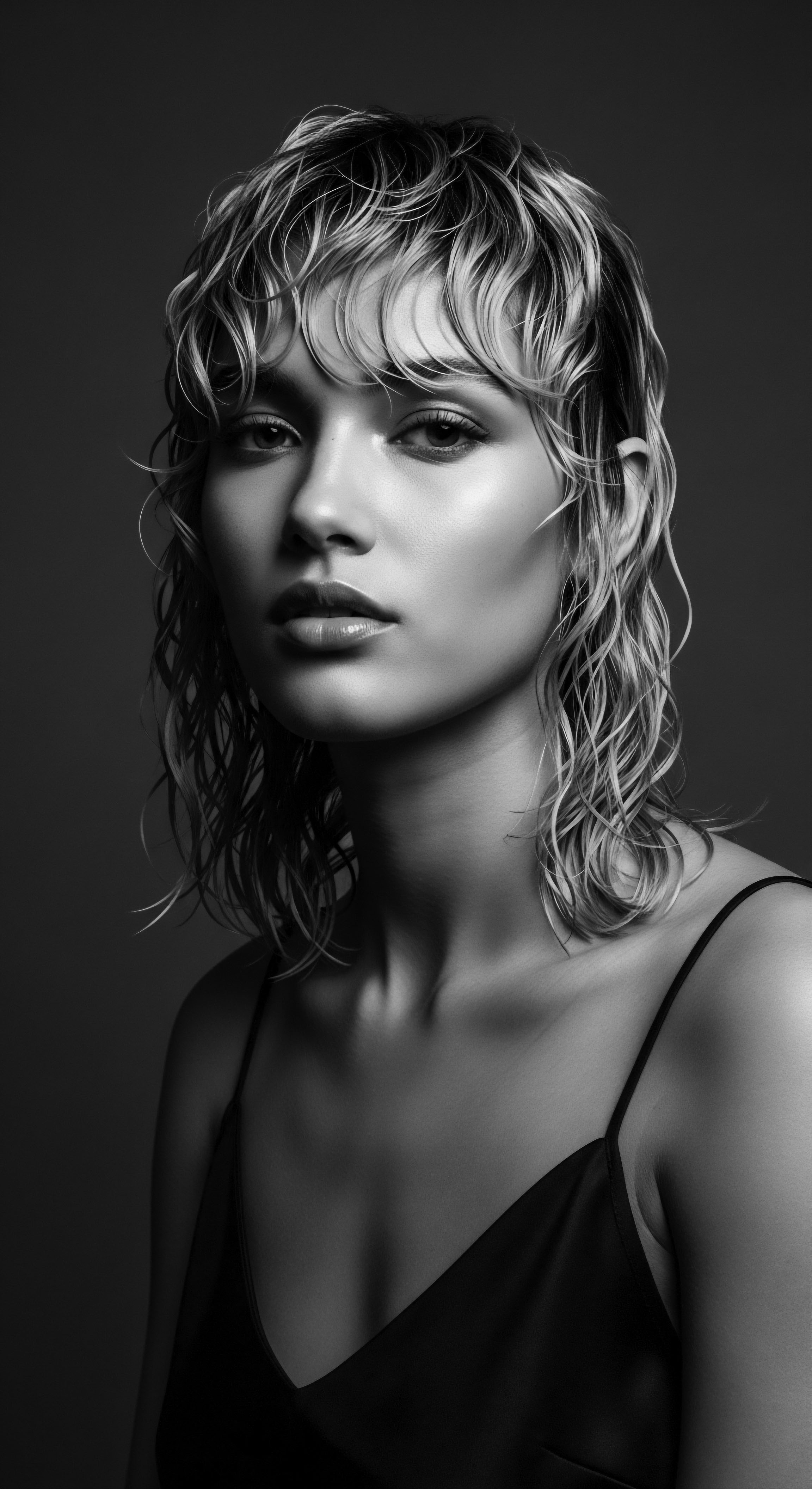
The Sun’s Caress and Challenge
Sunlight, an omnipresent element in human existence, comprises various wavelengths, among which ultraviolet radiation stands as a primary concern for hair health. Both ultraviolet A (UVA) and ultraviolet B (UVB) radiation penetrate the hair shaft, instigating different forms of degradation. UVB radiation, for instance, is primarily responsible for the loss of hair proteins, while UVA radiation often brings about noticeable changes in hair color. The absorption of these wavelengths by photosensitive amino acids within the hair initiates the formation of free radicals.
These highly reactive molecules, if left unchecked, inflict adverse impacts on the hair’s proteins, most notably Keratin. Keratin, the foundational protein of hair, contributes to its strength and elasticity. Any compromise to this protein compromises the hair’s overall vitality.
Hair, particularly textured hair, possesses a unique architecture that influences its interaction with solar radiation. While melanin, the pigment responsible for hair color, offers a measure of defense by absorbing and filtering UV rays, it can only provide partial protection. The cuticle, the hair’s outermost protective layer of overlapping scales, is vital for maintaining the hair shaft’s integrity. When this layer is compromised by UV exposure, hair becomes more porous, susceptible to moisture loss, and vulnerable to further damage.
Sun Vulnerability, simply put, is the hair’s innate openness to harm from the sun’s rays, a susceptibility deeply intertwined with hair’s unique structure and its ancestral lineage.

Whispers of Ancestral Knowledge
Before modern scientific instruments could dissect the wavelengths of light or analyze protein degradation, human communities intuitively understood the sun’s influence on their hair. Across diverse cultures, particularly those living under intense equatorial sun, practices emerged that offered protection. These were not random acts but rather carefully developed responses, passed down through generations, reflecting an intimate connection with the environment and a profound respect for hair’s well-being.
Consider the practices of early African communities, where hair held immense spiritual, social, and aesthetic meaning. Hair was not just adorned; it was guarded. Head coverings, such as the elaborate gele of West Africa or the functional dhoop scarves of East Africa, served not solely as markers of status or identity, but also as practical shields against the sun’s relentless heat.
Similarly, natural ingredients like shea butter and various plant oils, now celebrated for their moisturizing properties, were likely first employed as protective barriers. These ancestral practices, born of necessity and wisdom, were early forms of addressing what we now term Sun Vulnerability, demonstrating a timeless commitment to preserving hair’s resilience.
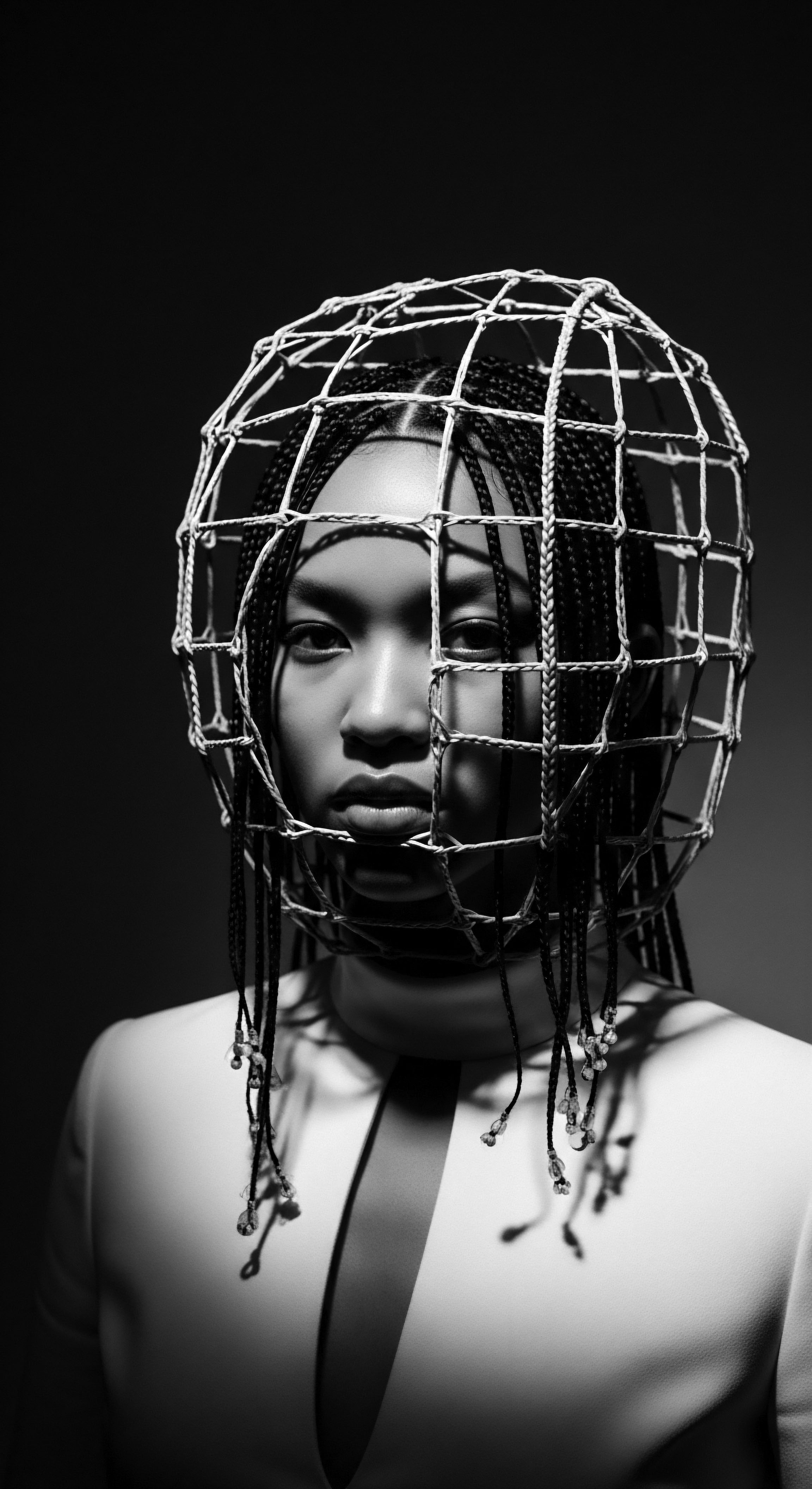
The Melanin Shield
Melanin, the biological pigment that bestows hair its rich spectrum of colors, plays a complex role in Sun Vulnerability. It absorbs solar radiation, attempting to dissipate this energy as heat, thereby offering a degree of photoprotection to the hair proteins. Darker hair types, which often possess higher concentrations of eumelanin, a more photostable pigment, exhibit increased resistance to changes in color compared to lighter hair colors. However, this protective mechanism is not absolute.
Melanin itself can degrade under prolonged UV exposure, leading to changes in hair color, or photobleaching, and diminishing its protective capacity over time. The initial resistance of darker, textured hair to color changes does not negate its overall vulnerability to the structural damage that UV radiation can inflict upon its protein matrix and lipid components.
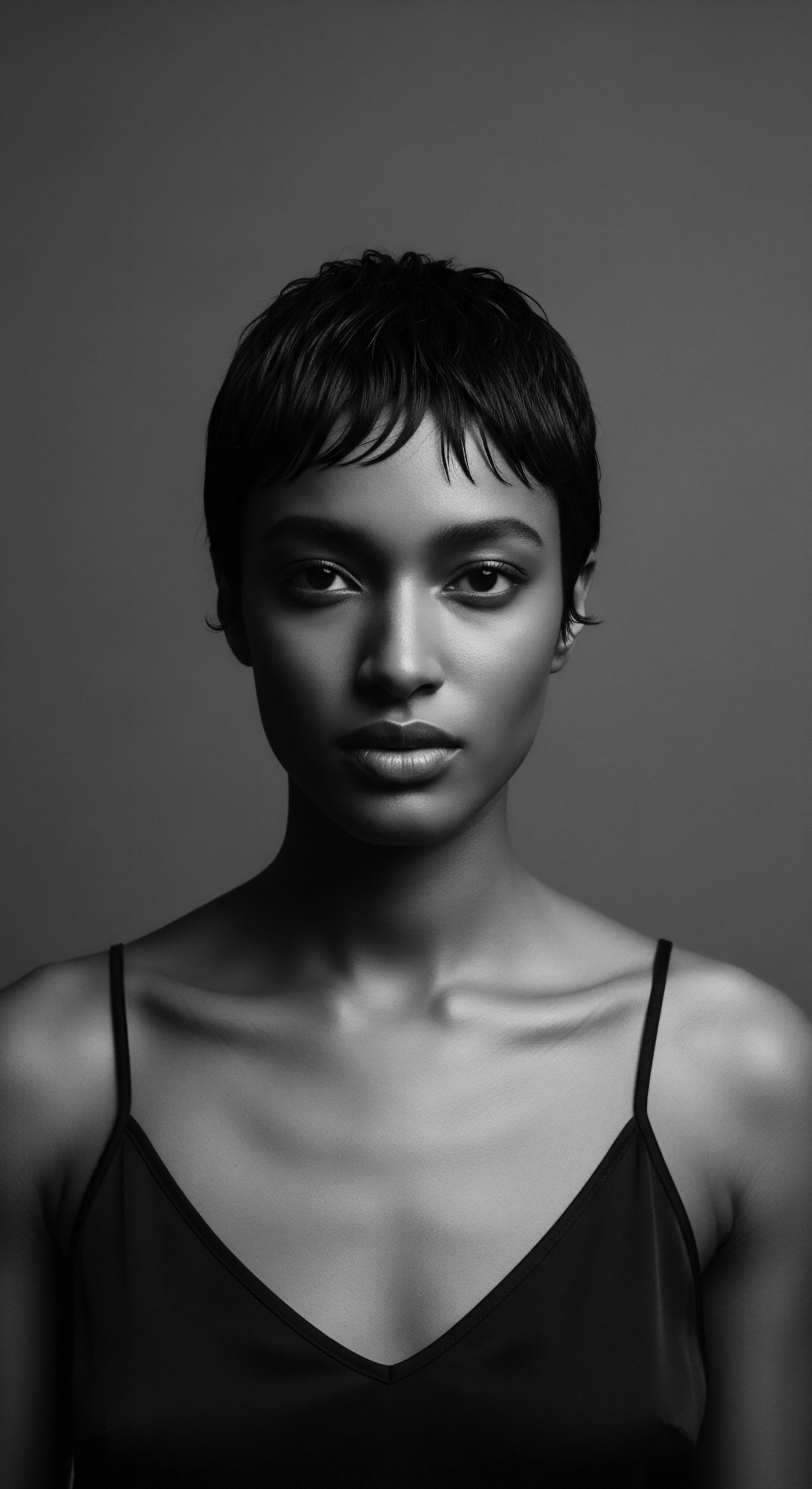
Intermediate
Stepping beyond the fundamental understanding, a more detailed interpretation of Sun Vulnerability reveals its specific impact on the intricate architecture of textured hair. This understanding is not merely academic; it informs the choices made in daily care and acknowledges the historical continuity of practices designed to safeguard hair from the elements. The sun’s influence extends far beyond a surface alteration, reaching into the very core of the hair strand to compromise its vitality.
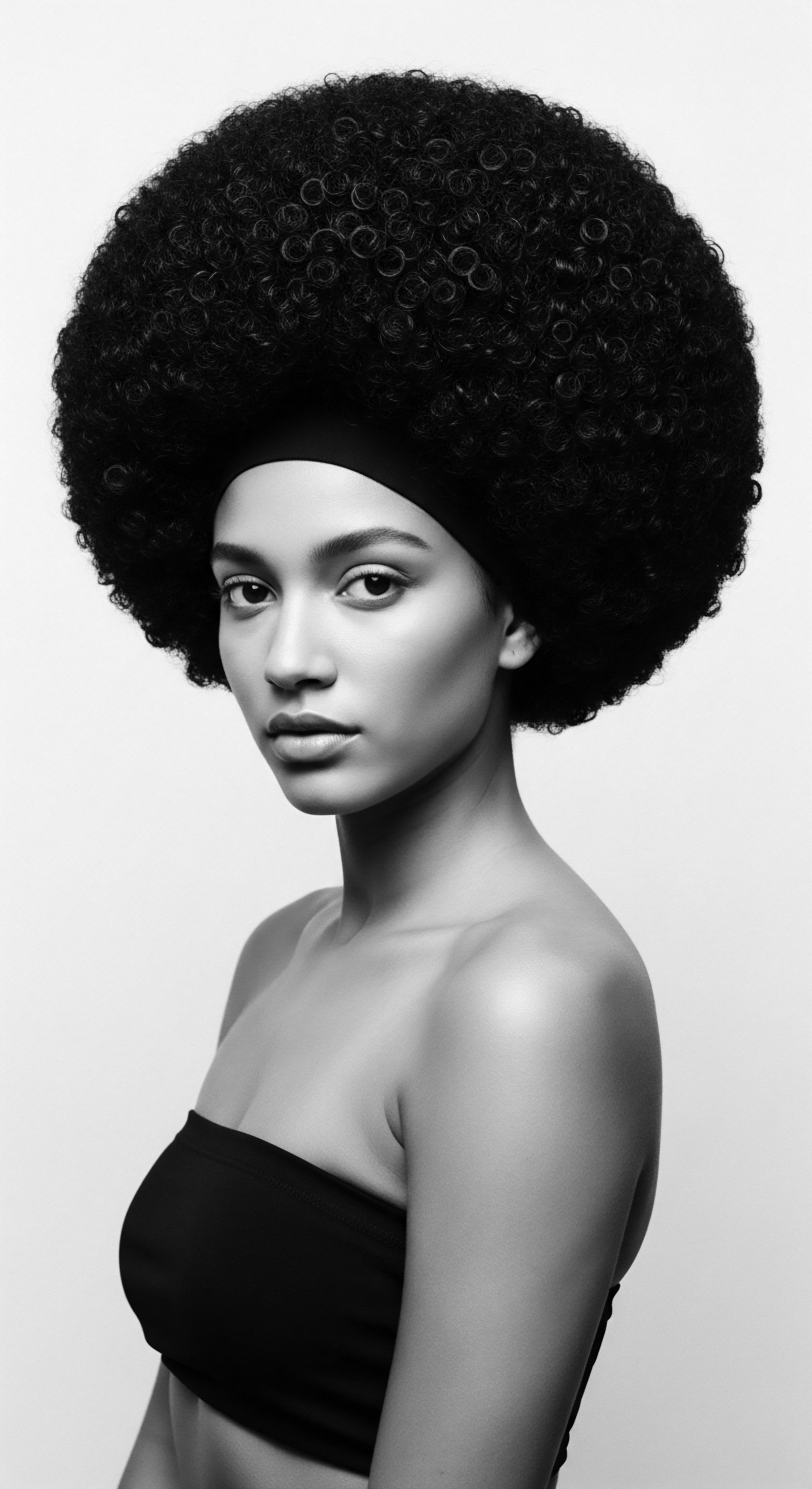
Deconstructing the Rays ❉ UV’s Mark on the Hair Strand
The sun’s radiant energy, composed of various wavelengths, engages in distinct interactions with hair. Specifically, ultraviolet A (UVA) and ultraviolet B (UVB) radiation each initiate particular forms of degradation within the hair shaft. UVB rays primarily target the delicate protein structures, leading to a loss of essential hair proteins, while UVA radiation is a significant contributor to unwanted alterations in hair color. These energetic wavelengths are absorbed by photosensitive amino acids, the fundamental building blocks of hair, triggering a cascade of photochemical reactions.
The result is the production of free radicals, unstable molecules that cause oxidative stress. This stress directly damages hair proteins, particularly keratin, the structural backbone of our strands.
Beyond protein loss, prolonged sun exposure also disrupts the hair’s lipid layers and the integrity of its cuticle, the outermost protective shield. When the cuticle’s scales lift or become damaged, the hair loses its natural defense against moisture evaporation, becoming dry, brittle, and rough to the touch. This increased porosity makes textured hair, which already tends to be more prone to dryness due to its coiled structure, even more susceptible to environmental stressors.
The hair’s natural luster diminishes, its strength is compromised, and it can exhibit increased stiffness. This cumulative damage, often referred to as “weathering,” represents a gradual weakening of the hair’s inherent resilience.

Sacred Shields ❉ Ancient Practices of Hair Protection
Long before the advent of modern chemistry, ancestral communities developed sophisticated methods for protecting their hair from the sun’s harshness. These practices were not born of scientific treatises but from generations of observation, experimentation, and deep reverence for hair. Across the African continent and its diaspora, hair care rituals were inextricably linked to survival, cultural identity, and well-being.
For millennia, natural oils and butters have served as vital tools in hair care. Shea butter, extracted from the fruit of the African shea tree, has been used for centuries across West Africa to protect both skin and hair from the sun, wind, and dust. Its rich composition of fatty acids and vitamins provides a nourishing barrier, helping to retain moisture and shield hair from environmental harm. This ancient understanding of shea butter’s protective qualities is corroborated by modern insights into its mild UV-filtering properties.
Consider also the widespread practice of hair wrapping and head coverings. From the gele in Nigeria to the doek in Southern Africa, these adornments served practical purposes beyond their aesthetic and social significance. They provided a tangible barrier against direct sunlight, mitigating exposure and helping to preserve hair’s moisture and structural integrity. This collective wisdom, passed down through the ages, embodies an ancestral science of hair protection.
Historical hair care practices, particularly among Black and mixed-race communities, reveal an intuitive wisdom regarding sun protection that often finds validation in contemporary scientific understanding.
The use of various substances for direct hair application demonstrates an early understanding of hair’s Sun Vulnerability ❉
- Shea Butter ❉ Employed across West Africa for centuries, offering moisture and a mild protective barrier against solar elements.
- Coconut Oil ❉ Valued for its moisturizing and conditioning properties, traditionally used to nourish and protect hair.
- Red Ochre Paste (Otjize) ❉ Notably used by the Himba tribe in Namibia, a mixture of ochre, butterfat, and aromatic resin applied to hair and skin, providing both cultural symbolism and practical sun protection.
- Chebe Powder ❉ Utilized by women in Chad for centuries to maintain hair length and health, implicitly aiding in overall hair resilience against environmental factors.

The Silent Language of Hair ❉ Sun, Status, and Survival
Hair has always been a powerful means of expression, a silent language communicating identity, status, and belief systems. For Black and mixed-race communities, particularly those forcibly displaced by the transatlantic slave trade, the relationship with hair, and its protection from the sun, gained layers of complex meaning. In many African cultures, hair was a reflection of spiritual beliefs, social standing, and age.
Hairstyles could indicate tribal affiliation, marital status, or even wealth. Protecting these intricate styles, often taking hours to create, was not just about physical preservation; it was about preserving a cultural legacy.
In the Americas, under the brutal institution of slavery, hair care transformed into an act of profound resistance. Enslaved Africans were often stripped of their traditional hair tools and methods, and their hair was sometimes shaved or altered as a means of control and dehumanization. Yet, practices like braiding persisted as quiet acts of defiance, a way to hold onto identity and tradition.
Head coverings, initially imposed as marks of subjugation, were defiantly reclaimed, becoming powerful symbols of pride, resilience, and even covert communication. These wraps, while protecting hair from the sun and dust, also allowed enslaved women to assert their dignity and connection to their ancestral homelands.
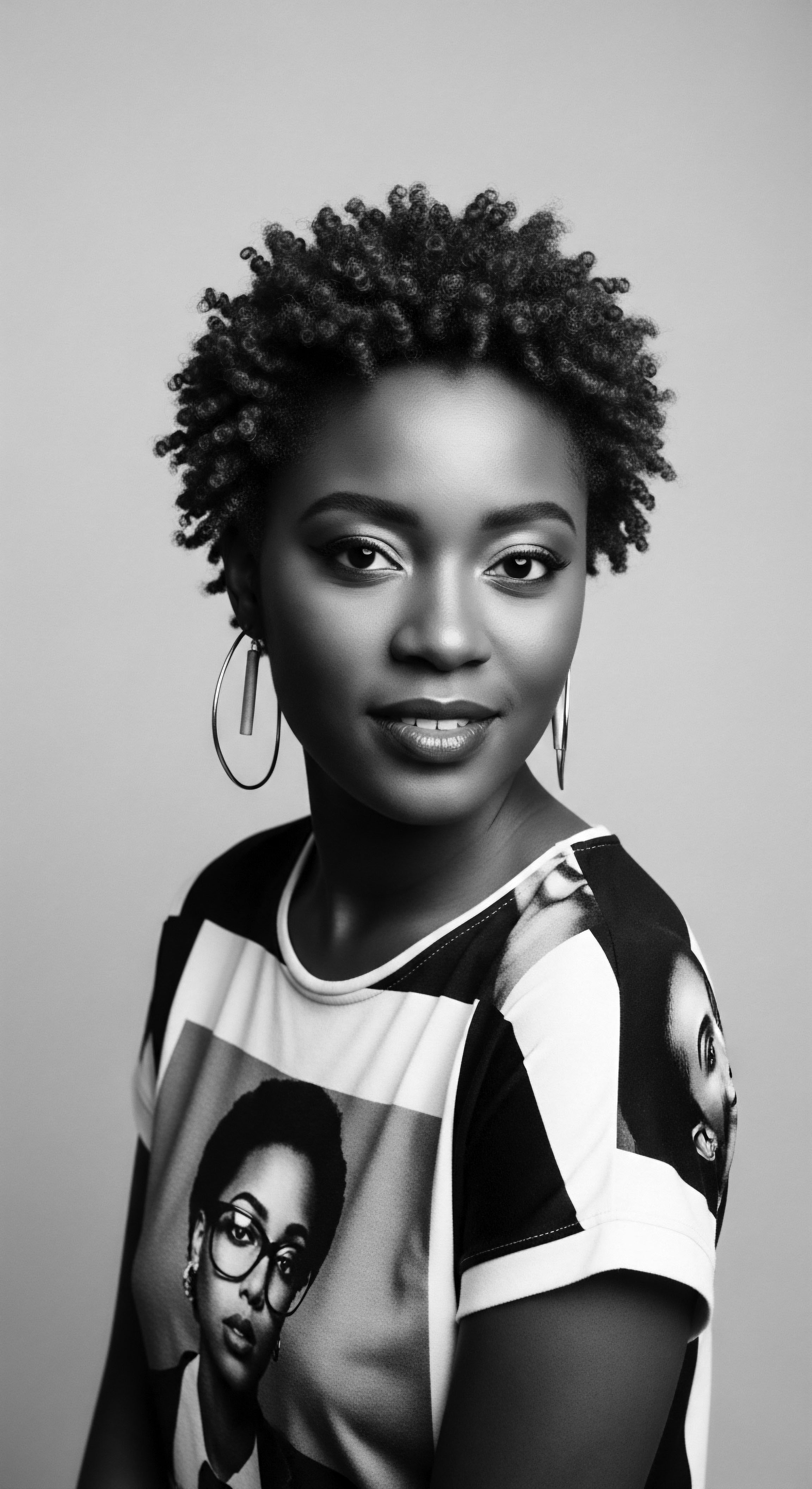
Academic
The academic understanding of Sun Vulnerability transcends a superficial recognition of solar damage, delving into the intricate biophysical and socio-historical dimensions that shape its meaning for textured hair. This scholarly perspective acknowledges that hair’s susceptibility to sunlight is a complex interplay of molecular reactions, evolutionary adaptations, and deeply rooted cultural practices, offering a comprehensive and expert-driven interpretation.

Defining Solar Susceptibility ❉ An Academic Lens
Sun Vulnerability, from an academic standpoint, can be articulated as the differential susceptibility of the hair fiber to photodegradation induced by ultraviolet and visible radiation, with a particular emphasis on how this phenomenon is mediated by inherent hair morphology, pigment composition, and extrinsic protective measures, especially within populations with textured hair. This interpretation extends beyond mere damage; it encompasses the systemic weakening of hair’s mechanical, chemical, and aesthetic properties. The meaning of Sun Vulnerability here is a multi-layered concept, encompassing the biophysical mechanisms by which solar energy alters keratin structure and melanin integrity, alongside the socio-historical consequences for hair health, identity, and care practices across diverse human populations.
The degradation of hair under sunlight, known as photo-degradation or photoaging, involves a series of complex photochemical events. UV radiation, particularly in the 254-400nm wavelength range, leads to structural impairment of the hair shaft. This process involves the oxidation of amino acids, particularly cysteine, tryptophan, tyrosine, and methionine, leading to the breakage of disulfide bonds that provide hair its strength and stability. The formation of reactive oxygen species (free radicals) is a key intermediary in these destructive pathways, prompting further protein loss and lipid peroxidation within the hair fiber.
For textured hair, the inherent characteristics of its curl pattern, alongside variations in cuticle layering and lipid content, can influence its response to solar exposure. While tightly coiled hair forms a natural barrier, protecting the scalp from direct solar radiation, the specific morphology can also make it more prone to dryness, which exacerbates sun-induced brittleness. Moreover, though darker hair contains more eumelanin, offering a degree of photoprotection to the cortex, the cuticle’s amino acids are equally susceptible to alteration, regardless of hair color, because this outer layer lacks significant pigmentation. This highlights that even melanated hair, while seemingly robust, experiences cumulative, irreversible damage from chronic sun exposure.

The Biophysical Dialogue ❉ Keratin, Melanin, and Photodegradation
At a molecular level, the dialogue between solar radiation and the hair fiber is one of energetic exchange, often resulting in degradation. Hair’s primary constituent, keratin, is a fibrous protein rich in sulfur-containing amino acids like cystine. UV radiation initiates the oxidation of these sulfur bridges, leading to the formation of cysteic acid and a consequential weakening of the hair’s structural integrity.
This manifests as reduced tensile strength, increased porosity, and a rougher surface texture. The impact on hair’s mechanical properties, such as elasticity and strength, directly correlates with the extent of protein degradation.
Melanin, the hair’s intrinsic pigment, endeavors to mitigate this degradation by absorbing and filtering incoming UV radiation, thereby dissipating the energy as heat. This protective function is particularly pronounced with eumelanin, the brown-black pigment, which exhibits greater photostability compared to pheomelanin, the red-yellow pigment. Despite melanin’s inherent photoprotective capabilities, prolonged or intense solar exposure inevitably leads to its degradation and bleaching. The process of photobleaching, while often perceived as a cosmetic alteration, signifies a compromise in the hair’s natural defense system, leaving the protein matrix more exposed to further damage.
Studies have shown that hair protein degradation is induced by wavelengths between 254 and 400 nm. The differential effects of UVA and UVB rays are distinct ❉ UVB primarily causes protein loss, affecting the cuticle first, while UVA penetrates deeper into the cortex, causing significant color changes through melanin degradation. The formation of free radicals, a critical outcome of UV absorption by hair’s amino acids, represents a substantial threat. These highly reactive species trigger oxidative stress, which systematically dismantles the molecular bonds within the hair fiber, leading to widespread damage to the cuticle, cortex, and even the hair follicle itself, potentially influencing growth cycles and overall hair health.
Sunlight’s engagement with hair initiates a complex chain of biophysical reactions, compromising keratin and melanin, thereby diminishing the hair’s inherent resilience and vibrancy.

Echoes of Resilience ❉ A Historical Perspective on Hair Protection in the Sahelian Corridor
The academic understanding of Sun Vulnerability finds a compelling grounding in the historical practices of communities residing in regions of intense solar radiation, such as the Sahelian Corridor of Africa. These environments compelled ingenious adaptations for hair protection, not merely for aesthetic purposes, but for survival and the maintenance of communal identity. The Himba people of Namibia, a semi-nomadic tribe, provide a profound historical example of an ancestral practice directly addressing solar susceptibility.
For centuries, Himba women have meticulously applied otjize, a reddish paste composed of ground ochre, butterfat, and sometimes aromatic resin, to their skin and hair. This ritual, while carrying deep cultural and aesthetic meaning—symbolizing blood, fertility, and earth—also served as a remarkably effective natural sunscreen and hair protectant.
Modern scientific investigations have validated this ancestral wisdom. Research conducted circa 2015 confirmed that red ochre is rich in ferrous oxide, a potent physical sunblock, effectively shielding both skin and hair from the sun’s harsh UV rays. This ancient practice, maintained through generations, exemplifies a sophisticated, albeit empirically derived, understanding of Sun Vulnerability. It allowed the Himba to endure and thrive in one of the planet’s most arid and sun-drenched environments, maintaining the vitality and characteristic elegance of their hair while colonialists, unaware of such natural defenses, succumbed to the sun’s ravages.
This case underscores a critical point ❉ while modern science can meticulously dissect the molecular mechanisms of UV damage, ancestral communities often arrived at highly effective solutions through observational knowledge and generational wisdom. The otjize ritual is not an isolated instance. Similar protective practices, though perhaps less documented by Western science, existed across diverse African groups, utilizing locally sourced materials to create barriers against solar exposure. These collective practices form a rich testament to human ingenuity and the enduring relevance of traditional knowledge in addressing environmental challenges, specifically the vulnerability of hair to solar radiation.
| Traditional Practice/Ingredient Otjize (Red Ochre Paste) |
| Region of Origin Namibia (Himba people) |
| Reported Protective Function Against Sun Physical barrier, UV blocking (ferrous oxide), moisture retention. |
| Traditional Practice/Ingredient Shea Butter (Karité) |
| Region of Origin West Africa (Shea Belt) |
| Reported Protective Function Against Sun Moisture sealant, mild UV absorption, protective barrier. |
| Traditional Practice/Ingredient Head Wraps / Scarves |
| Region of Origin Various African cultures and African Diaspora |
| Reported Protective Function Against Sun Physical shielding from direct sunlight, scalp protection, moisture retention. |
| Traditional Practice/Ingredient Chebe Powder |
| Region of Origin Chad (Basara Arab women) |
| Reported Protective Function Against Sun Promotes hair strength and length, which indirectly aids in overall resilience to environmental stressors. |
| Traditional Practice/Ingredient These practices highlight the ancestral ingenuity in safeguarding hair from solar impacts, reflecting a deep cultural connection to hair's well-being. |

Sociocultural Implications of Sun-Hair Interactions Across the Diaspora
The physical reality of Sun Vulnerability casts long shadows across sociocultural landscapes, particularly within the African diaspora. Hair, a potent symbol of identity, has been subjected to Eurocentric beauty standards that often devalued textured hair and its natural responses to environmental factors. During slavery, the forced shaving of heads and the imposition of head coverings, while sometimes offering physical protection from the sun, were often instruments of dehumanization and control, severing the deep cultural ties that hair held for enslaved Africans. Yet, even within these oppressive contexts, the act of maintaining or protecting hair, even covertly, became a quiet defiance, a means to preserve a fragmented heritage.
The enduring impact of solar exposure on hair texture and appearance also intersects with the complex history of colorism. Lighter hair, often seen as more desirable within colonial beauty hierarchies, was sometimes achieved through chemical treatments or styling that further compromised hair health, making it even more susceptible to environmental damage. Conversely, the natural beauty and resilience of dark, textured hair, often optimally adapted for sun protection, was frequently misunderstood or maligned. The perception of Sun Vulnerability, therefore, extends beyond biology to encompass the societal pressures that shaped hair care practices and beauty ideals throughout history, particularly for Black and mixed-race communities.
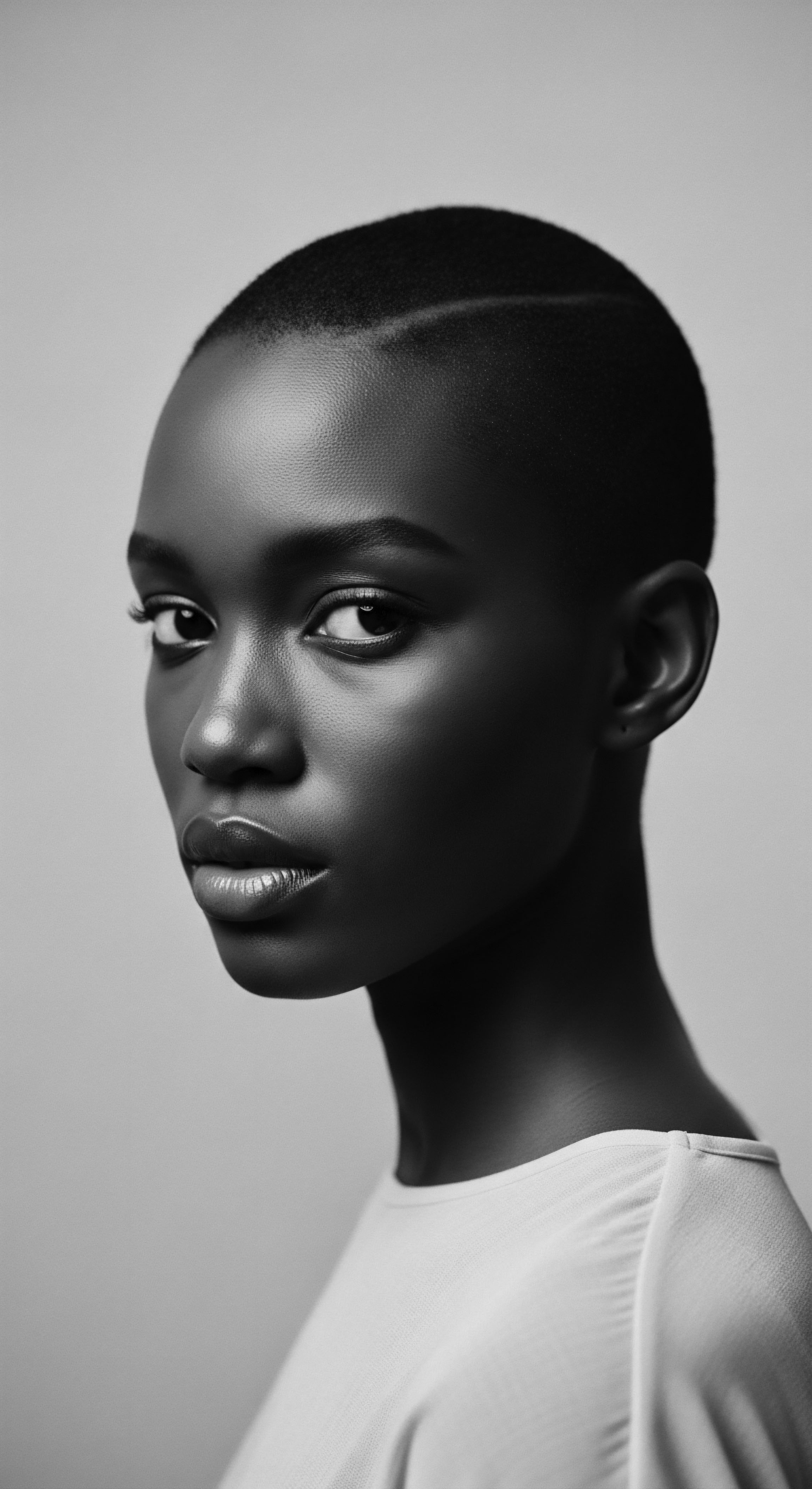
Future Directions in Hair Care ❉ Reclaiming Ancestral Wisdom
An academic understanding of Sun Vulnerability also points towards future directions in textured hair care, advocating for approaches that integrate scientific advancements with a reclamation of ancestral wisdom. The recognition that traditional ingredients like shea butter offer tangible benefits in mitigating sun damage opens pathways for the development of modern formulations that honor these historical precedents. The architectural advantages of tightly coiled hair in scalp protection, acknowledged by contemporary anthropology, reaffirms the inherent brilliance of natural hair states.
This integrative approach calls for rigorous research into the protective properties of traditionally used botanical extracts and minerals, exploring their mechanisms of action and optimal applications. It also advocates for the development of culturally sensitive educational programs that demystify the science of sun damage for textured hair, while simultaneously celebrating the historical resilience and ingenious adaptive strategies of ancestral communities. The meaning of Sun Vulnerability, in this forward-looking context, becomes a catalyst for empowering individuals to make informed choices about their hair care, rooted in both scientific understanding and a profound respect for their heritage.

Reflection on the Heritage of Sun Vulnerability
To truly comprehend Sun Vulnerability for textured hair is to listen to the whisper of generations, to feel the sun’s warmth and its persistent touch, and to recognize the enduring spirit of adaptability. It is a concept that extends far beyond clinical definitions, reaching into the very soul of a strand, tracing its lineage through time and across continents. Our hair, particularly that which carries the legacy of coils, kinks, and waves, has always been a testament to resilience, a living archive of environmental interaction and human ingenuity. The challenges posed by the sun, from the earliest human migrations in equatorial lands to the contemporary experiences of Black and mixed-race communities worldwide, have sculpted not only our hair’s physical attributes but also the profound rituals and cultural understandings that surround it.
The tender thread of hair care, woven through millennia, speaks to an ancestral knowing that anticipated modern science. The protective wraps, the rich butters, the earthen pigments—these were not mere adornments; they were profound acts of preservation, born of an intuitive recognition of hair’s elemental openness to the sun’s embrace and its fierce vulnerability. As we stand today, armed with both cutting-edge research and the echoes of ancient wisdom, we are called to honor this legacy. Our understanding of Sun Vulnerability becomes a bridge, connecting the precise molecular explanations of photodegradation to the communal hearths where hair was braided, oiled, and adorned with reverence.
It is a call to protect, to celebrate, and to continue the living tradition of care that safeguards the unbound helix, allowing each strand to tell its story of beauty, resilience, and ancestral pride. The sun’s power, when understood through this heritage-lens, becomes a reminder of the deep well of wisdom our ancestors drew from, a wisdom that continues to guide our hands in nurturing our cherished hair.
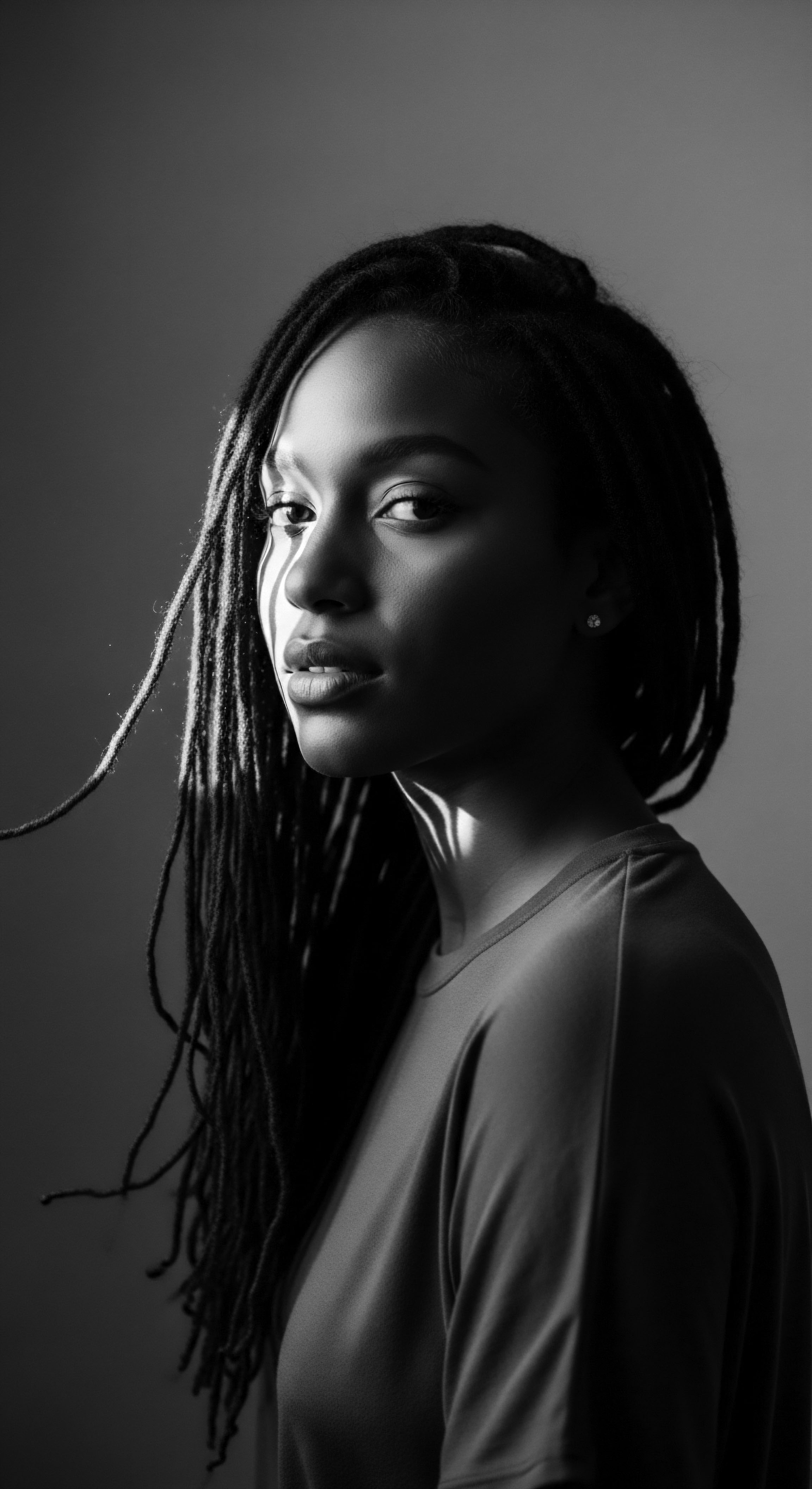
References
- Zebetić, K. Sjerobabski Masnec, I. Ćavka, V. Biljan, D. & Krolo, I. (2008). UV damage of the hair. Collegium Antropologicum, 32(Suppl 2), 163-165.
- Zebetić, K. Sjerobabski Masnec, I. Ćavka, V. Biljan, D. & Krolo, I. (2008). UV Damage of the Hair. Collegium Antropologicum, 32(Suppl 2), 163-165.
- Nogueira, A. C. S. & Joekes, I. (2004). Hair color changes and protein damage caused by ultraviolet radiation. Photochemistry and Photobiology, 80(2), 241-246.
- Sana, N. (2024, March 28). The Sun, Heat, and Your Afro Hair. Noma Sana.
- Ari Party Hair. (2025, February 18). The History and Symbolism of Hair Wrapping Across the African Diaspora. Ari Party Hair.
- Sonson. (2021, April 24). The History of Headwraps and Black Culture. Sonson.
- Marshall, N. (2023, June 8). Curly hair may have evolved to keep early humans cool, study suggests. The Standard.
- BA Notes. (2023, November 16). The Diversity of Hair Characteristics Across Human Populations. BA Notes.
- Bebrų Kosmetika. (2024, August 23). The Power of Hair in African Folklore ❉ Rituals and Traditions. Bebrų Kosmetika.
- Green Views Residential Project. (2022, October 5). History of the African head wrap. Green Views Residential Project.
- Nogueira, A. C. S. & Joekes, I. (2012, January 5). Photodamage determination of human hair. PubMed.
- Africa Imports. The Cultural Significance of the African Headwrap. Africa Imports.
- Laifen-EU. (2024, November 5). What is the Hair Cuticle? Structure, Causes of Damage & Repair Tips. Laifen-EU.
- Fusion Salon. (2024, July 9). Protect Your Locs from the Summer Sun ❉ Essential Hair Care Tips. Fusion Salon.
- Wraps n’ Raps. (2024, June 12). African American Head Wrap History ❉ From Slavery to Contemporary Pride. Wraps n’ Raps.
- Citizen Wolf. Hands Up For Red Ochre. Citizen Wolf.
- SAVE ME FROM. (2022, April 21). How does sun and sweat damage your hair? SAVE ME FROM.
- Black Skin Directory. (2023, July 6). Sun, Sea and Afro Hair. Black Skin Directory.
- Health, V. (2024, July 10). Hair Photobleaching ❉ Effects of Sun, Safety, and Reversal. Verywell Health.
- Root2tip. (2024, July 6). Afro Hair and Climate ❉ Adapting Your Routine to Weather Changes. Root2tip.
- The Afro Curly Hair Coach. (2023, February 25). PROTECTING YOUR AFRO CURLY HAIR FROM SUN DAMAGE. Gege The Afro Curly Hair Coach.
- Mother Nature’s Conditioner ❉ Shea Butter. (2017, November 30). Mother Nature’s Conditioner.
- Soares, L. G. Reis, M. H. & Cavalcante, M. M. S. (2014). Photoaggravation of Hair Aging. Journal of Cosmetics, Dermatological Sciences and Applications, 4(02), 79.
- Idowu, O. C. Markiewicz, E. & Oladele, D. (2024). Grades of cuticle layer damage assessed by TEM. ResearchGate.
- Nogueira, A. C. S. & Joekes, I. (2011). Photodamage determination of human hair. Photochemistry and Photobiology.
- Dr.UGro Gashee. (2020, March 12). Red Ochre as a Skin and Hair Sunblock an Old Himba Discovery. Dr.UGro Gashee.
- Beauty Garage. (2021, April 17). Shea Butter Benefits for Skin ❉ a Nourishing Secret From Ancient Africa. Beauty Garage.
- Macintyre, K. & Dobson, B. (n.d.). Ochre ❉ an ancient health-giving cosmetic. Anthropology from the Shed.
- Ibiene. (2019, September 13). The Red Ochre Of The Himba…. Ibiene Magazine.
- Cut by Fred. (2022, June 2). UV rays and hair ❉ 3 effects you don’t know. Cut by Fred.
- Natural Beauty. (2024, February 10). Discovering the Origins of Shea Butter – A Journey to the Heart of Africa. Natural Beauty.
- Bidhaar. (2020, August 5). Red Ochre ❉ The Himba of Namibia. Bidhaar.
- African American Registry. (n.d.). Black Hair Care and Its Culture, a story. African American Registry.
- Beauty Garage. The Globalization of Shea Butter. Natural Shea Hair Care by Beauty Garage.
- Beauty Garage. (2025, January 23). Hair Care Practices from the Diaspora ❉ A Look at Africa, America, and Europe. Natural Shea Hair Care by Beauty Garage.
- Hunter, C. (2024, August 22). Black Hair Is a Safe Sport Issue! ❉ Black Aesthetics, Access, Inclusion, and Resistance in. Black Hair Is a Safe Sport Issue!.
- Kyei, C. (2023, August 23). Women in Beauty Cultures and Aesthetic Rituals in Africa. Oxford Research Encyclopedia of African History.
- The Chocolate Voice. (n.d.). Anthropologist on a mission to remove racial prejudices from the study of Black hair. The Chocolate Voice.
- The Hair & Beauty Co. (2024, August 19). Hair Care Secrets of the Past ❉ What Our Ancestors Used for Healthy Hai. The Hair & Beauty Co.
- Obscure Histories. (2024, May 8). The Globalization of Shea Butter. Obscure Histories.
- Aidoo, M. & Amedofu, A. (2019). The Evolution of Skin Pigmentation and Hair Texture in People of African Ancestry. American Journal of Physical Anthropology.
- Afrocenchix. (2020, August 4). Sun Protection for Hair ❉ How to Save Your Strands from the Sun. Afrocenchix.
